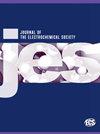Utilization of DEM Simulations to Quantify Cell Level Thickness and Volume Changes in Large Format Pouch Cells
IF 3.3
4区 工程技术
Q2 ELECTROCHEMISTRY
引用次数: 0
Abstract
In this work, a 3D representation of a lithium ion electric vehicle battery cell was created and modeled through the discrete element method (DEM) to capture the porous electrode volume change during cell operation and its effects on electrode strain, porosity changes, and pressure generation for each electrode. This was coupled with a representative volume element approach and the multi species reaction model to quantify the impact of these changes at an electrode level have on the cell level operation. Results on both the electrode level and cell level response were discussed to give insights on how the volume changes contribute to both strain and porosity changes and the potential effects these changes have on the electrochemical response of the generated representative cells. Predictions on the cell level response, particularly for porosity changes which can be difficult to capture experimentally, are essential for the further development of high energy density cells that utilize unique chemistries prone to high levels of volume change such as silicon and silicon oxides. The ability to predict the active material volume change and its nuances will be informative and essential to rapidly develop and design cells for both automotive and grid storage applications.利用 DEM 仿真量化大型袋状细胞的细胞级厚度和体积变化
在这项研究中,我们创建了锂离子电动汽车电池的三维模型,并通过离散元素法(DEM)进行建模,以捕捉电池运行过程中多孔电极体积的变化及其对电极应变、孔隙率变化和每个电极压力产生的影响。这种方法与代表性体积元素方法和多物种反应模型相结合,可量化电极层面的这些变化对电池层面运行的影响。对电极级和电池级响应的结果进行了讨论,以深入了解体积变化如何导致应变和孔隙率变化,以及这些变化对生成的代表性电池的电化学响应的潜在影响。电池级响应的预测,尤其是难以通过实验捕捉的孔隙率变化的预测,对于进一步开发利用硅和硅氧化物等易发生高水平体积变化的独特化学材料的高能量密度电池至关重要。预测活性材料体积变化及其细微差别的能力将为快速开发和设计汽车和电网储能应用电池提供重要信息。
本文章由计算机程序翻译,如有差异,请以英文原文为准。
求助全文
约1分钟内获得全文
求助全文
来源期刊
CiteScore
7.20
自引率
12.80%
发文量
1369
审稿时长
1.5 months
期刊介绍:
The Journal of The Electrochemical Society (JES) is the leader in the field of solid-state and electrochemical science and technology. This peer-reviewed journal publishes an average of 450 pages of 70 articles each month. Articles are posted online, with a monthly paper edition following electronic publication. The ECS membership benefits package includes access to the electronic edition of this journal.

 求助内容:
求助内容: 应助结果提醒方式:
应助结果提醒方式:


